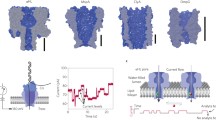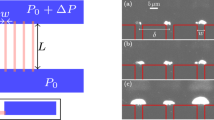Abstract
Flow of ions through narrow pores, either induced in biological membranes or created in synthetic membrane filters, exhibits, under appropriate conditions: 1) rapid switching of ion current between high and low conducting states; 2) selectivity between different ions; 3) inhibition by protons or divalent cations with an order of efficacy usually H+ >Zn2+>Ca2+ >Mg2+. It seems reasonable to conclude that these common properties arise from a common cause-the nature of the flow of ions close to a charged surface.
Similar content being viewed by others
References
Alder, G. M., Arnold, W. M., Bashford, C. L., Drake, A. F., Pasternak, C. A. and Zimmermann, U. (1991) Divalent cation-sensitive pores formed by natural and synthetic melittin and by Triton X-100.Biochim. Biophys. Acta 1061:111–120.
Apel, P. Y., Didyk, A. Y., Kravets, L. I. and Kuznetsov, V. I. (1990) Track structure in some heavy-ion irradiated plastic films.Nucl. Tracks Radiat. Meas. 17:191–193.
Avigad, L. S. and Bernheimer, A. W. (1976) Inhibition by zinc of hemolysis induced by bacterial and other cytolytic agents.Infect. Immun. 13:1378–1381.
Bashford, C. L., Alder, G. M., Patel, K. and Pasternak, C. A. (1984) Common action of certain viruses, toxins, and activated complement: pore formation and its prevention by extracellular Ca2+.Biosci. Rep. 4:797–805.
Bashford, C. L., Micklem, K. J. and Pasternak, C. A. (1985) Sequential onset of permeability changes in mouse ascites cells induced by Sendai virus.Biochim. Biophys. Acta 814:247–255.
Bashford, C. L., Alder, G. M., Menestrina, G., Micklem, K. J., Murphy, J. J. and Pasternak, C. A. (1986) Membrane damage by hemolytic viruses, toxins, complement, and other cytotoxic agents. A common mechanism blocked by divalent cations.J. Biol. Chem. 261:9300–9308.
Bashford, C. L., Alder, G. M., Graham, J. M., Menestrina, G. and Pasternak, C. A. (1988a) Ion modulation of membrane permeability: effect of cations on intact cells and on cells and phospholipid bilayers treated with pore-forming agents.J. Membrane Biol. 103:79–94.
Bashford, C. L., Menestrina, G., Henkart, P. A. and Pasternak, C. A. (1988b) Cell damage by cytolysin. Spontaneous recovery and reversible inhibition by divalent cations.J. Immunol. 141:3965–3974.
Binnig, G., Quate, C. F. and Gerber, C. (1986) Atomic force microscope.Phys. Rev. lett. 56:930–933.
Boulnois, G. J., Mitchell, T. J., Saunders, K.et al. (1991) Analysis of some putative protein virulence factors ofStreptococcus pneumoniae. In: Dunny, G. M., Cleary, P. P., McKay, L. L. (eds) Genetics and Molecular Biology of Streptococci, Lactococci, and Enterococci. American Society for Microbiology, Washington DC, USA, pp. 83–87.
Boyle, M. D., Langone, J. J. and Borsos, T. (1979) Studies on the terminal stages of immune hemolysis. IV. Effect of metal salts.J. Immunol. 122:1209–1213.
Burnet, F. M. (1949) Haemolysis by Newcastle disease virus.Nature 164:1008.
Colowick, S. P. and Womack, F. C. (1969) Binding of diffusible molecules by macromolecules: rapid measurement by rate of dialysis.J. Biol. Chem. 244:774–777.
Elferink, J. G. (1991) Changes of plasma membrane permeability in neutrophils treated with polycations.Inflammation 15:103–115.
Feldmann, K. (1978) New devices for flow dialysis and ultrafiltration for the study of protein-ligand interactions.Anal. Biochem. 88:225–235.
Gotze, O., Haupt, I. and Fischer, H. (1968) Immune haemolysis: Reaction of the terminal component of complement.Nature 217:1165–1167.
Hamill, O. P., Marty, A., Neher, E., Sakmann, B. and Sigworth, F. J. (1981) Improved patch-clamp techniques for high resolution current recording from cells and. cell-free membrane patches.Pflugers Archiv. 391:85–100.
Hansma, P. K., Drake, B., Marti, O., Gould, S. A. and Prater, C. B. (1989) The scanning ion-conductance microscope.Science 243:641–643.
Harshman, S. and Sugg, N. (1985) Effect of calcium ions on staphylococcal alpha-toxin-induced hemolysis of rabbit erythrocytes.Infect. Immun. 47:37–40.
Impraim, C. C., Micklem, K. J. and Pasternak, C. A. (1979) Calcium, cells and virus-alterations caused by paramyxoviruses.Biochem. Pharmacol. 28:1963–1969.
Knowles, B. H., Blatt, M. R., Tester, M., Horsnell, J. M., Carroll, J., Menestrina, G. and Ellar, D. J. (1989) A cytolytic delta-endotoxin fromBacillus thuringiensis var.israelensis forms cationselective channels in planar lipid bilayers.FEBS Lett. 244:259–262.
Korchev, Y. E., Bashford, C. L. and Pasternak, C. A. (1992) Differential sensitivity of pneumolysininduced channels to gating by divalent cations.J. Membrane Biol. 127:195–203.
Korchev, Y. E., Alder, G. M., Bakhramov, A., Bashford, C. L., Joomun, B. S., Sviderskaya, E. V., Usherwood, P. N. R. and Pasternak, C. A. (1995)Staphylococcus aureus alpha toxin-induced pores: channel-like behaviour in lipid bilayers and patch-clamped cells.J. Membrane Biol. 143:143–151.
Krasilnikov, O. V., Sabirov, R. Z., Ternovsky, V. I., Merzliak, P. G. and Tashmukhamedov, B. A. (1988) The structure ofStaphylococcus aureus alpha-toxin-induced ionic channels.Gen. Physiol. Biophys. 7:467–473.
Krasilnikov, O. V., Sabirov, R. Z., Ternovsky, V. I., Merzliak, P. G., Muratkhodjaev, J. N. (1992) A simple method for the determination of the pore radius of ion channels in planar lipid bilayer membranes.FEMS Microbiol. Immunol. 5:93–100.
Lev, A. A. (1990) Sterol-dependent inactivation of gramicidin-A induced ionic channels in the cell and artificial lipid bilayer membranes. In: Kuczera, J., Przestalski, S. (eds) Biophysics of Membrane Transport: Proceedings of Tenth School. Agricultural University, Wrocslaw, Poland, pp. 231–250.
Lev, A. A., Korchev, Y. E., Rostovtseva, T. K., Bashford, C. L., Edmonds, D. T. and Pasternak, C. A. (1993) Rapid switching of ion current in narrow pores: implications for biological ion channels.Proc. Roy. Soc. B 252:187–192.
Liu, J. W. and Blumenthal, K. M. (1988) Membrane damage byCerebratulus lacteus cytolysin A-III. Effects of monovalent and divalent cations on A-III hemolytic activity.Biochim. Biophys. Acta 937:153–160.
Madigan, S. J., Whitbread, J. A. and Katz, E. R. (1990) ADictyostelium discoideum mutant exhibiting calcium-dependent, high-level detergent resistance.J. Bact. 172:2785–2787.
Mahadevan, D., Ndirika, A., Vincent, J., Bashford, L., Chambers, T. and Pasternak, C. (1990) Protection against membrane-mediated cytotoxicity by calcium and zinc.Am. J. Path. 136:513–520.
Menestrina, G. (1986) Ionic channels formed byStaphylococcus aureus alpha-toxin: Voltage-dependent inhibition by divalent and trivalent cations.J. Membrane Biol. 90:177–190.
Menestrina, G., Bashford, C. L. and Pasternak, C. A. (1990) Pore-forming toxins: experiments withS. aureus alpha-toxin,C. perfringens theta-toxin andE. coli haemolysin in lipid bilayers, liposomes and intact cells.Toxicon 28:477–491.
Micklem, K. J., Alder, G. M., Buckley, C. D., Murphy, J. and Pasternak, C. A. (1988) Protection against complement-mediated cell damage by Ca2+ and Zn2+.Complement 5:141–152.
Mironov, S. L., Sokolov, Yu. V., Chanturiya, A. N. and Lishko, V. K. (1986) Channels produced by spider venoms in bilayer lipid membrane: mechanisms of ion transport and toxic action.Biochim. Biophys. Acta 862:185–198.
Pasternak, C. A., Alder, G. M., Bashford, C. L. and Menestrina, G. (1989) The role of lipids in permeability changes induced by toxins and other cytolytic agents. In: Karbara, J. J. (ed) The Pharmacological Effects of Lipids III. The American Oil Chemists' Society, Champaign, IL, pp. 64–68.
Pasternak, C. A., Bashford, C. L., Korchev, Y. E., Rostovtseva, T. K. and Lev, A. A. (1993) Modulation of surface flow by divalent cations and protons.Colloids and Surfaces 77:119–124.
Pasternak, C. A., Alder, G. M., Apel, P. Y., Bashford, C. L., Edmonds, D. T., Korchev, Y. E., Lev, A. A., Lowe, G., Milovanovic, M., Pitt, C. W., Rostovtseva, T. K. and Zhitariuk, N. I. (1995) Nuclear track-etched filters as model pores for biological-membranes.Radiation Measurements 25:675–683.
Pasternak, C. A. and Micklem, K. J. (1973) Permeability changes during cell fusion.J. Membrane Biol. 14:293–303.
Pasternak, C. A., Micklem, K. J. (1974) The biochemistry of virus-induced cell fusion. Changes in membrane integrity.Biochem. J. 140:405–411.
Patel, K. and Pasternak, C. A. (1985) Permeability changes elicited by influenza and Sendai viruses: separation of fusion and leakage by pH-jump experiments.J. Gen. Virol. 66:767–775.
Poste, G. and Pasternak, C. A. (1978) Virus-induced cell fusion. In: Poste, G., Nicolson, G. L. (eds) Cell Surface Reviews Vol. 5 North Holland Publishing, New York, pp. 306–349.
Prater, C. B., Hansma, P. K., Tortonese, M. and Quate, C. F. (1991) Improved scanning ion-conductance microscope using microfabricated probes.Rev. Sci. Instrum. 62:2634–2638.
Rostovtseva, T. K., Bashford, C. L., Lev, A. A. and Pasternak, C. A. (1994) Triton channels are sensitive to divalent cations and protons.J. Membrane Biol. 141:83–90.
Rostovtseva, T. K., Bashford, C. L., Alder, G. M., Hill, G. N., McGiffert, C, Apel, P. Y., Lowe, G. and Pasternak, C. A. (1996) Diffusion through narrow pores: movement of ions, water and non-electrolytes through track-etched PETP membranes.J. Membrane Biol. 151: (in press).
Samoilova, L. I. and Apel, P. Y. (1995) Etching of small pores in PETP by different alkalis.Radiat. Measur. 25:717–720.
Thelestam, M. and Mollby, R. (1980) Interaction of streptolysin O fromStreptococcus pyogenes and theta-toxin fromClostridium perfringens with human fibroblasts.Infect. Immun. 29:863–872.
Wilmsen, H. U., Pattus, F. and Buckley, J. T. (1990) Aerolysin, a hemolysin fromAeromonas hydrophila, forms voltage-gated channels in planar lipid bilayers.J. Membrane Biol. 115:71–81.
Yamamoto, K. and Takahashi, M. (1975) Inhibition of the terminal stage of complement-mediated lysis (reactive lysis) by zinc and copper ions.Int. Arch. Allergy Appl. Immunol. 48:653–663.
Yeomans, L., Feller, S. E., Sanchez, E. and Lozadacassou, M. (1993) The structure of electrolytes in cylindrical pores.J. Chem. Phys. 98:1436–1450.
Author information
Authors and Affiliations
Rights and permissions
About this article
Cite this article
Bashford, C.L. Membrane pores—From biology to track-etched membranes. Biosci Rep 15, 553–565 (1995). https://doi.org/10.1007/BF01204357
Received:
Issue Date:
DOI: https://doi.org/10.1007/BF01204357




